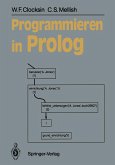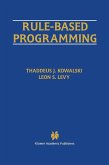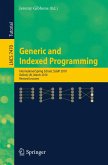60,95 €
60,95 €
inkl. MwSt.
Sofort per Download lieferbar

30 °P sammeln
60,95 €
Als Download kaufen

60,95 €
inkl. MwSt.
Sofort per Download lieferbar

30 °P sammeln
Jetzt verschenken
Alle Infos zum eBook verschenken
60,95 €
inkl. MwSt.
Sofort per Download lieferbar
Alle Infos zum eBook verschenken

30 °P sammeln
- Format: PDF
- Merkliste
- Auf die Merkliste
- Bewerten Bewerten
- Teilen
- Produkt teilen
- Produkterinnerung
- Produkterinnerung

Bitte loggen Sie sich zunächst in Ihr Kundenkonto ein oder registrieren Sie sich bei
bücher.de, um das eBook-Abo tolino select nutzen zu können.
Hier können Sie sich einloggen
Hier können Sie sich einloggen
Sie sind bereits eingeloggt. Klicken Sie auf 2. tolino select Abo, um fortzufahren.

Bitte loggen Sie sich zunächst in Ihr Kundenkonto ein oder registrieren Sie sich bei bücher.de, um das eBook-Abo tolino select nutzen zu können.
A workbook for programmers who are new to Prolog and who wish to write useful Prolog programs, by the first author of the runaway bestseller "Programming in Prolog" (with C.S. Mellish).
- Geräte: PC
- ohne Kopierschutz
- eBook Hilfe
- Größe: 10.07MB
Andere Kunden interessierten sich auch für
![Programming in Prolog (eBook, PDF) Programming in Prolog (eBook, PDF)]() William F. ClocksinProgramming in Prolog (eBook, PDF)56,95 €
William F. ClocksinProgramming in Prolog (eBook, PDF)56,95 €![Programmieren in Prolog (eBook, PDF) Programmieren in Prolog (eBook, PDF)]() William F. ClocksinProgrammieren in Prolog (eBook, PDF)36,99 €
William F. ClocksinProgrammieren in Prolog (eBook, PDF)36,99 €![Pattern Calculus (eBook, PDF) Pattern Calculus (eBook, PDF)]() Barry JayPattern Calculus (eBook, PDF)128,95 €
Barry JayPattern Calculus (eBook, PDF)128,95 €![Prolog: The Standard (eBook, PDF) Prolog: The Standard (eBook, PDF)]() Pierre DeransartProlog: The Standard (eBook, PDF)80,95 €
Pierre DeransartProlog: The Standard (eBook, PDF)80,95 €![Specification and Transformation of Programs (eBook, PDF) Specification and Transformation of Programs (eBook, PDF)]() Helmut A. PartschSpecification and Transformation of Programs (eBook, PDF)40,95 €
Helmut A. PartschSpecification and Transformation of Programs (eBook, PDF)40,95 €![Rule-Based Programming (eBook, PDF) Rule-Based Programming (eBook, PDF)]() Thaddeus J. KowalskiRule-Based Programming (eBook, PDF)112,95 €
Thaddeus J. KowalskiRule-Based Programming (eBook, PDF)112,95 €![Generic and Indexed Programming (eBook, PDF) Generic and Indexed Programming (eBook, PDF)]() Generic and Indexed Programming (eBook, PDF)36,95 €
Generic and Indexed Programming (eBook, PDF)36,95 €-
-
-
A workbook for programmers who are new to Prolog and who wish to write useful Prolog programs, by the first author of the runaway bestseller "Programming in Prolog" (with C.S. Mellish).
Dieser Download kann aus rechtlichen Gründen nur mit Rechnungsadresse in A, B, BG, CY, CZ, D, DK, EW, E, FIN, F, GR, HR, H, IRL, I, LT, L, LR, M, NL, PL, P, R, S, SLO, SK ausgeliefert werden.
Produktdetails
- Produktdetails
- Verlag: Springer Berlin Heidelberg
- Seitenzahl: 143
- Erscheinungstermin: 6. Dezember 2012
- Englisch
- ISBN-13: 9783642582745
- Artikelnr.: 53091672
- Verlag: Springer Berlin Heidelberg
- Seitenzahl: 143
- Erscheinungstermin: 6. Dezember 2012
- Englisch
- ISBN-13: 9783642582745
- Artikelnr.: 53091672
- Herstellerkennzeichnung Die Herstellerinformationen sind derzeit nicht verfügbar.
1. Getting Started.- 1.1 Syntax.- 1.2 Programs.- 1.3 Unification.- 1.4 Execution Model.- 2. Data Structures.- 2.1 Square Bracket Notation.- 2.2 Arithmetic.- 3. Mapping.- Worksheet 10: Full Maps.- Worksheet 11: Multiple Choices.- Worksheet 12: Partial Maps.- Worksheet 13: Removing Duplicates.- Worksheet 14: Partial Maps with a Parameter.- Worksheet 15: Multiple Disjoint Partial Maps.- Worksheet 16: Multiple Disjoint Partial Maps.- Worksheet 17: Full Maps with State.- Worksheet 18: Sequential Maps with State.- Worksheet 19: Scattered Maps with State.- 4. Choice and Commitment.- 4.1 The 'Cut'.- 4.2 A Disjoint Partial Map with Cut.- 4.3 Taming Cut.- 4.4 Cut and Negation-as-Failure.- 4.5 Negation-as-Failure Can Be Misleading.- 5. Difference Structures.- Worksheet 25: Concatenating Lists.- Worksheet 26: Rotations of a List.- Worksheet 27: Linearising.- 5.1 Difference Lists.- 5.2 Solution to Max Tree.- 6. Case Study: Term Rewriting.- 6.1 Symbolic Differentiation.- 6.2 Matrix Products by Symbolic Algebra.- 6.3 The Simplifier.- 7. Case Study: Manipulation of Combinational Circuits.- 7.1 Representing Circuits.- 7.2 Simulation of Circuits.- 7.3 Sums and Products.- 7.4 Simplifying SOP Expressions.- 7.5 Alternative Representation.- 8. Case Study: Clocked Sequential Circuits.- 8.1 Divide-by-Two Pulse Divider.- 8.2 Sequential Parity Checker.- 8.3 Four-Stage Shift Register.- 8.4 Gray Code Counter.- 8.5 Specification of Cascaded Components.- 9. Case Study: A Compiler forThree Model Computers.- 9.1 The Register Machine.- 9.2 The Single-Accumulator Machine.- 9.3 The Stack Machine.- 9.4 Optimisation: Preprocessing the Syntax Tree.- 9.5 Peephole Optimisation.- 10. Case Study: The Fast Fourier Transform in Prolog.- 10.1 Introduction.- 10.2 Notation for Polynomials.- 10.3 The DFT.- 10.4Example: 8-point DFT.- 10.5 Naive Implementation of the DFT.- 10.6 From DFT to FFT.- 10.7 Merging Common Subexpressions.- 10.8 The Graph Generator.- 10.9 Example Run: 8-point FFT.- 10.10 Bibliographic Notes.- 11. Case Study: Higher-Order Functional Programming.- 11.1 Introduction.- 11.2 A Notation for Functions.- 11.3 The Evaluator.- 11.4 Using Higher-Order Functions.- 11.5 Discussion.- 11.6 Bibliographic Notes.
1. Getting Started.- 1.1 Syntax.- 1.2 Programs.- 1.3 Unification.- 1.4 Execution Model.- 2. Data Structures.- 2.1 Square Bracket Notation.- 2.2 Arithmetic.- 3. Mapping.- Worksheet 10: Full Maps.- Worksheet 11: Multiple Choices.- Worksheet 12: Partial Maps.- Worksheet 13: Removing Duplicates.- Worksheet 14: Partial Maps with a Parameter.- Worksheet 15: Multiple Disjoint Partial Maps.- Worksheet 16: Multiple Disjoint Partial Maps.- Worksheet 17: Full Maps with State.- Worksheet 18: Sequential Maps with State.- Worksheet 19: Scattered Maps with State.- 4. Choice and Commitment.- 4.1 The 'Cut'.- 4.2 A Disjoint Partial Map with Cut.- 4.3 Taming Cut.- 4.4 Cut and Negation-as-Failure.- 4.5 Negation-as-Failure Can Be Misleading.- 5. Difference Structures.- Worksheet 25: Concatenating Lists.- Worksheet 26: Rotations of a List.- Worksheet 27: Linearising.- 5.1 Difference Lists.- 5.2 Solution to Max Tree.- 6. Case Study: Term Rewriting.- 6.1 Symbolic Differentiation.- 6.2 Matrix Products by Symbolic Algebra.- 6.3 The Simplifier.- 7. Case Study: Manipulation of Combinational Circuits.- 7.1 Representing Circuits.- 7.2 Simulation of Circuits.- 7.3 Sums and Products.- 7.4 Simplifying SOP Expressions.- 7.5 Alternative Representation.- 8. Case Study: Clocked Sequential Circuits.- 8.1 Divide-by-Two Pulse Divider.- 8.2 Sequential Parity Checker.- 8.3 Four-Stage Shift Register.- 8.4 Gray Code Counter.- 8.5 Specification of Cascaded Components.- 9. Case Study: A Compiler forThree Model Computers.- 9.1 The Register Machine.- 9.2 The Single-Accumulator Machine.- 9.3 The Stack Machine.- 9.4 Optimisation: Preprocessing the Syntax Tree.- 9.5 Peephole Optimisation.- 10. Case Study: The Fast Fourier Transform in Prolog.- 10.1 Introduction.- 10.2 Notation for Polynomials.- 10.3 The DFT.- 10.4Example: 8-point DFT.- 10.5 Naive Implementation of the DFT.- 10.6 From DFT to FFT.- 10.7 Merging Common Subexpressions.- 10.8 The Graph Generator.- 10.9 Example Run: 8-point FFT.- 10.10 Bibliographic Notes.- 11. Case Study: Higher-Order Functional Programming.- 11.1 Introduction.- 11.2 A Notation for Functions.- 11.3 The Evaluator.- 11.4 Using Higher-Order Functions.- 11.5 Discussion.- 11.6 Bibliographic Notes.







